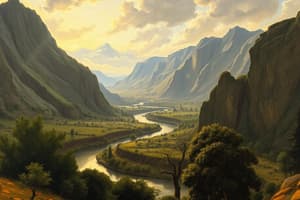Podcast
Questions and Answers
Explain why the river in the upland areas flows over steep, hard rocks?
Explain why the river in the upland areas flows over steep, hard rocks?
The river in the upland areas flows over steep, hard rocks due to the elevated terrain and geological composition.
Describe the channel of the river in the upper course.
Describe the channel of the river in the upper course.
In the upper course, the river's channel is narrower, shallower, and V-shaped with rough edges.
Why does the river become wider in the lowlands?
Why does the river become wider in the lowlands?
The river becomes wider in the lowlands due to lateral erosion of the riverbanks by abrasion and hydraulic action.
Explain the process that leads to the load (stones, pebbles) becoming rounder and smoother in the lowlands.
Explain the process that leads to the load (stones, pebbles) becoming rounder and smoother in the lowlands.
What causes the increase in discharge in the lowlands of the river?
What causes the increase in discharge in the lowlands of the river?
How does the average velocity of the river change as it moves from the upper course to the lower course?
How does the average velocity of the river change as it moves from the upper course to the lower course?
Explain why the channel of the river is shallower in the upper course.
Explain why the channel of the river is shallower in the upper course.
Flashcards are hidden until you start studying
Study Notes
River Characteristics in Upland and Lowland Areas
Upland Areas
- Rivers in upland areas flow over steep, hard rocks due to the landscape's high relief and rapid runoff.
- The channel in the upper course is narrow, steep-sided, and has a high gradient.
Lowland Areas
- Rivers become wider in the lowlands due to the gentler slope, increased sediment load, and reduced velocity.
- The process of attrition, where stones and pebbles collide and wear each other down, leads to the load becoming rounder and smoother in the lowlands.
- The increase in discharge in the lowlands is caused by the river's smaller gradient, allowing it to collect and transport more water from surrounding areas.
- The average velocity of the river decreases as it moves from the upper course to the lower course due to the decrease in gradient.
Channel Characteristics
- The channel of the river is shallower in the upper course due to the high gradient, which leads to a faster flow and increased erosion, resulting in a narrower and deeper channel.
Studying That Suits You
Use AI to generate personalized quizzes and flashcards to suit your learning preferences.




